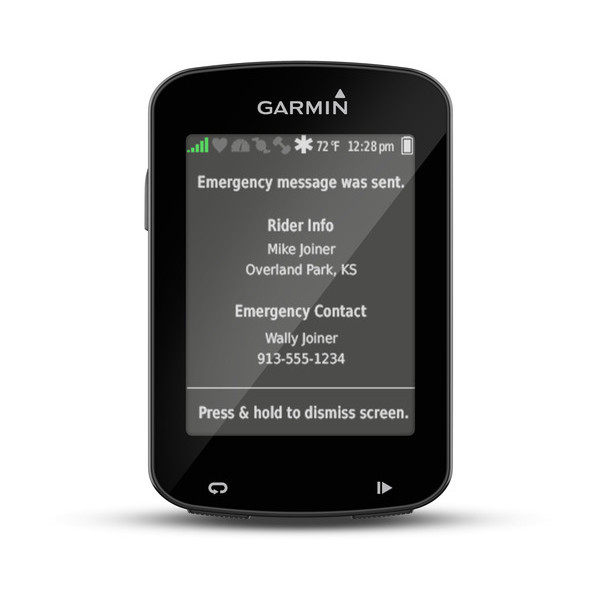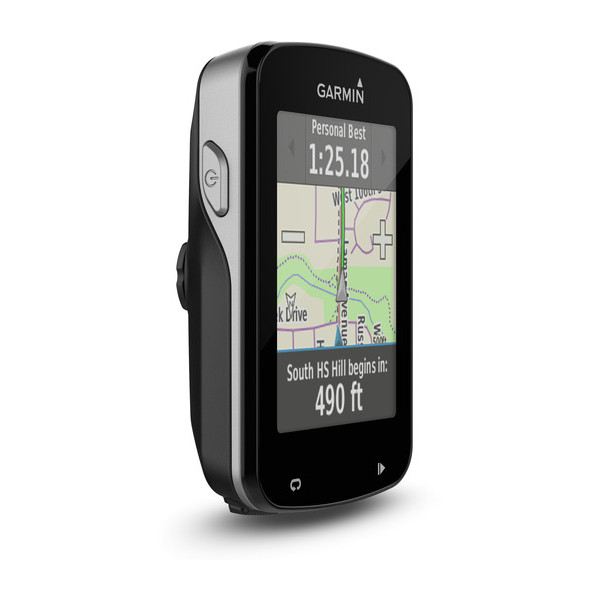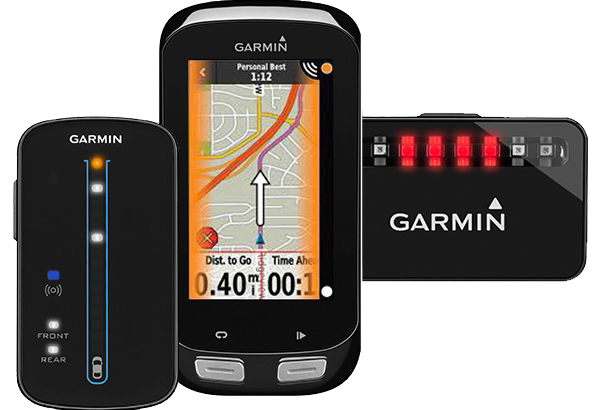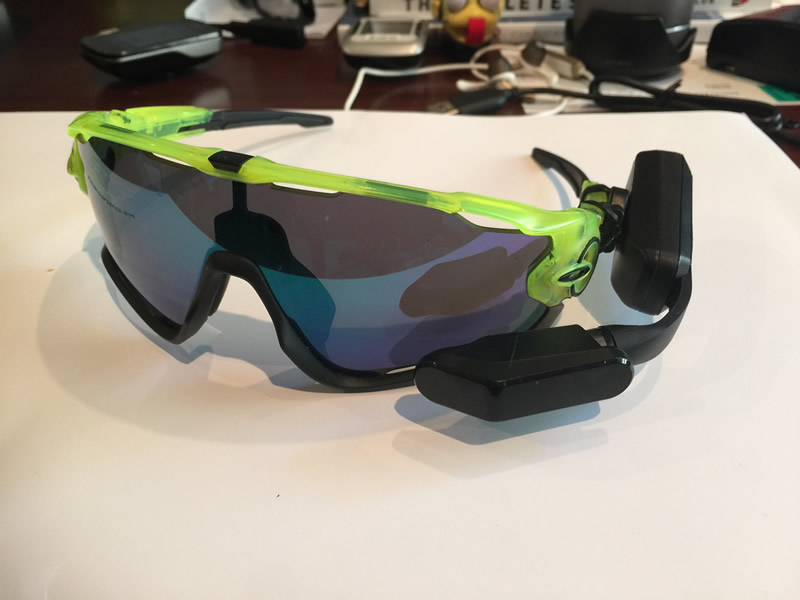Garmin Edge 820: Garmin Varia Suite Part 3

The Edge 820 is the latest flagship compact bike computer from Garmin. Regardless of screen size or price, the Edge 820 is the most fully functional unit in the Garmin line-up. It has by far the most features of any unit they offer. If you want Garmin's best Edge computer, for now, this is it (with a few caveats). That they chose to stuff all these features into the compact form factor tells me what I've intuited anecdotally all along – people want the smaller form factor.

LIVETRACK, GROUPTRACK, AND STRAVA BEACON
For a long time, when I first got back on the bike in 2010 after my accident, I always rode with a SPOT beacon. The SPOT uses a satellite communication chip, so even if you have poor cellphone coverage, as I do in some areas where I ride, people can track you. One of the hardest parts of my accident was the panic that my wife endured not knowing where I was when I should have been home. The SPOT was our solution in case anything ever happened again. Less with the idea in mind of another crash, but more in terms of her not panicking if somehow I was out longer than I should have been because of something like a flat tire. We both valued the "coverage anywhere" nature of SPOT, but the overwhelming majority of the time, I ride in places with good cell coverage. So carrying yet another device, especially one with a relatively large ($150) annual fee, got to be a hassle.
While it's limited by cell phone coverage, Garmin nicely provides the LiveTrack feature for free. It uses your cellphone to update your position on Garmin's Connect website in semi-real time. You specify whether or not you want to allow tracking for a given activity in the Connect app on your phone. From there, you can share a link either via social media for public tracking or privately via email. LiveTrack has been available for a while, but I still think few people know about it.
What's new, with GroupTrack, is that you can also share your location to other folks with connected Garmin devices. While this is obviously mostly "social," I can see a safety factor here as well if you are riding with friends and get separated during something like a fast descent. These things don't happen often, but I know of several cases where this exact scenario unfolded where GroupTrack could have helped. Obviously, in both cases, this is not something that is likely to save your life, but it's a huge value in terms of reducing the worry that, unfortunately, often comes with riding.
For some time now, Strava has offered a feature called Beacon to users of its mobile app. Beacon sends a notification to up to three pre-set contacts when you start an activity allowing them to track you on the web. Again, this is reliant on a functional cell signal. One nice thing here was that the notification and link was sent out automatically when you started a ride. As Strava and Garmin have become more cooperative – offering things like LiveSegments during your ride, they've expanded away from just the competitive aspect of Strava. Recently, they've basically merged Beacon with Garmin's LiveTrack. On a compatible device, you can now use LiveTrack to automatically trigger your Beacon alert. There is some obvious redundancy here between the two, but the end result is that it's easier than ever to make use of these features to let your family know that you're headed out riding or where you are. While there's obviously nothing about this that keeps you, the athlete, safe, it does offer some peace of mind.

INCIDENT DETECTION
The biggest feature, from a safety standpoint, is the new incident detection feature. This feature uses the 820's internal accelerometer to register large impacts and to then use your connected-via-bluetooth phone to alert predesignated emergency contacts with an alert that includes your GPS location (on a map).
The incident detection algorithm is hard to test in terms of actual efficacy in the field, for obvious reasons. So I tried to get a sense of the sort of force required to trigger an alert. Ray Maker of DC Rainmaker found early testing to register a lot of false positives. Testing a production unit, I had no false positives, but I also struggled to even get the unit to register what I thought was a pretty big hit in "testing" (using the terms loosely).
I dropped the 820 onto a thin rug over my tile floor from about waist (3ft) height. Nothing happened. I raised my arm over my head and dropped it onto the floor from call it 8ft. Nothing happened. I tossed the unit gently onto the rug. Nothing happened. I threw the unit a bit harder than I was comfortable with onto the rug. Nothing happened. But the unit itself seemed totally unfazed so…
I threw the unit a lot harder than I really thought I ought to onto the floor. Again, the unit was unfazed either cosmetically or otherwise. But this time, within a couple seconds, the unit gave me the emergency screen and started beeping at me. Beeping is the wrong word… It started yelling at me. My phone also started emitting a siren call. You will not miss this if it happens accidentally. You have 30 seconds to cancel the emergency notification from the 820's screen. You have to press a graphical button on the touchscreen to cancel and then again press and hold a graphical button to confirm, so it seems quite hard to accidentally cancel the alert, which is a good thing. You can also cancel it from your phone (on the off chance that your unit went flying somewhere, and that is what caused the incident).
Unfortunately, I wasn't ready with my camera, so I did not get a photo of the "incident," and I couldn't bring myself to really hurl the 820 into the ground quite that hard again. I'm not sure whether or not this gives me confidence in terms of how effective it would be in real life. On the one hand, I certainly don't want it going off all the time on a bumpy road. At the same time, I threw this thing pretty darn hard, and it didn't set it off. Overall, I'd say I view this as something that might work, but also might not. Bike crashes happen in all sorts of different ways, which makes it tough. But the algorithm used here is easily updated as Garmin refines it to pick up more scenarios. I'd say, if it does save your bacon, great. If not, well, it never promised that it would.
Overall, I like it better than the ICE sensor, which I also have, but which has been extremely flaky in terms of maintaining a connection with my phone. The powerful computer inside the 820 seems to do a great job of maintaining the bluetooth connection to the phone. The ICE sensor – and I've had two of them – never seems to be able to keep a connection active longer than – at most – 90min. And, even more in favor of using something like the Edge for incident detection, it tells you if your phone disconnects. You have to look at your phone to see if the ICE has dropped.
However, the ICE does mount to your helmet, which is obviously a much a more practical location in terms of registering an impact. I wonder if Garmin couldn't enhance the incident detection feature further by making a small, rechargeable ANT+ unit that would mount to the helmet like the ICE does. ANT+ is, in my experience, more reliable than Bluetooth. I'd love to see such a sensor get added to the Varia line in the future.
It's important to note – and Garmin emphasizes this – that they do not contact emergency services. The 820 is not going to call 9-1-1 for you. But it will alert your contacts – and provide your location's GPS coordinates on a map – to allow them to contact 9-1-1.
If somehow you miss the 30 second countdown, you can automatically send an, "I'm okay!" message. You swipe down on the home screen which brings up your "Connections" pane. From there, select "Incident Detected" and "I'm Okay." The message gets sent automatically from within the SMS app on your phone (for example iMessage, so you can also just go and follow up there with a more in depth explanation as to what happened). Because I couldn't get the incident to re-trigger, I wasn't able to test this, so I'm simply quoting from the Edge 820 manual here.

TOUCH SCREEN FUNCTION
I didn't intend to cover this, because it has nothing to do with safety, but sweat and rain both proved surprisingly problematic for the touch screen. I had page changes just from pouring sweat on the unit thanks to Kona's excessively high humidity. I also had page changes and even field changes when I got caught in a heavy rain storm in Kona. It wasn't a huge problem, but I did find overall functionality was somewhat compromised in the wet. Compared with the physical buttons of my Edge 520, I just don't see the value of the touch screen while I am riding. I have an Edge 500, which I still love. Then I "upgraded" to an Edge 510, and I never really found the touchscreen to be a benefit. The Edge 510 felt like a step back from the 500. Whereas the Edge 520 (with its physical buttons) felt like a clear upgrade.
The 820 splits the difference here. It packs a lot more features into a compact form than the 510 did over the 500. The 820 does more than the 520 does, but they may not be things you're inclined to use – like navigation. It is, however, much easier to make use of a lot of the 820's features with the touch screen. Navigating menus, building workouts, changing settings, and any time you have to interact with the unit are much better on the touch screen. But that makes life easier at your desk or in the garage before or after a ride. When you are riding? The touchscreen is a nuisance. It's easy to accidentally push the wrong section or even, simply, to make a mess of the screen because you are swiping it with a booger-laden finger. You can lock the screen so that it doesn't respond to "accidental" presses, but then you lose some of the functionality of the unit.
There are settings for touch sensitivity – I had it on the "middle" setting to start – but unfortunately, I didn't end up with another rainstorm to test these with. I thought about doing a "shower" test, but having never done something like that before, I wouldn't feel confident saying that it was a reliable proxy in either direction. In other words, if the touch screen had problems in the shower or if it didn't, would that be a reasonable proxy for riding in the rain? I just don't have enough prior experience to say so definitively either way.
Overall, the touchscreen here continues to have the problems I've had with every touchscreen device from Garmin – Edge 800, Edge 510, and Forerunner 610, though I think this is a touchscreen problem not a Garmin problem. I've never used a touchscreen computer or watch from anyone else, so I can't say that Garmin is worse here. I have a lot of the same problems with my iPhone in a waterproof case, but I don't actually need to interact with it in the rain or when I'm super sweaty nearly as much as I need to interact with my Garmins. Touchscreens, in general, are all awesome to interact with when you are not training, and all are more cumbersome to interact with when you are. There's no good answer here, and I don't fault Garmin for the decisions they make here. People would complain either way. Building a workout or doing anything involved on a button-press unit is frustratingly slow. Touchscreens, on the other hand, are simply not precise enough yet (and may never be) to handle inputs while someone is engaged in strenuous activity and sweating.
I will say that the issues here with the 820's touchscreen simply further emphasize just how nice the Varia Vision is. I was able to leave my 820 set to display total ride data while the Varia Vision displayed my lap information. In this way, I was able to minimize the issues of the touchscreen because I had a dual display, and the information I cared most about what always right in front of me.

DISPLAY
One thing that I still do miss about the 500 as compared with every other Garmin unit that has come after it was how the 500 changed the size of display for different fields. This is something I'd love to see you be able to tweak.
With my Garmin 500, I typically had four fields and the 500 split them up like this:
Power (3s avg) / Time / Avg Cad — Avg Power
What I really, really liked was that 50% of the display was given to the first field. That made it really easy to see, with just a quick glance, the power I was holding. Now, again, this is yet another plus for the Varia Vision. You never have to look here. The issue of course is that the Varia Vision is not necessarily something people will want – or be able – to race with. Of course, the display on the 820 is bigger and more clear than the display on the 500, nevertheless, I really miss the asymmetrical display formatting of the 500 and wish you could tweak what percentage of the display each field received.

PRICE
$399. This is cheaper than either of the larger Edge 1000 devices, but it's still a lot for a device that only works for cycling. If you are someone that wants a do-it-all unit, like the 920 or 735, it might be hard to justify dropping another chunk like this on a bike computer. Of these two, the 735XT does work with the Varia Vision, but I was not able to test this and reports on the web indicate it's not quite as clean as on the Edge devices. The 920 does not support (yet) the Varia Vision. Personally, I've always used run-specific and bike-specific Garmin device, because I think there are just too many compromises otherwise. I've bought all of my own devices retail, just like anyone else. These are the first units I've ever received from Garmin. To me, the cost is high, but most definitely worthwhile.
CONCLUSION
I tried to basically leave out any discussion of the typical Garmin features here. If you want an in-depth review of the unit overall, check out Ray Maker's excellent review here. I would have only covered the impact detection and interaction with the Varia Vision except for the fact that the touchscreen was more finicky than I thought it should be.
Overall, the Edge 820 is a great little unit. It does everything you'd expect from a flagship Garmin unit, including really powerful mapping with navigation and the "friends" feature called GroupTrack. Power data, great GPS functionality, WiFi and Bluetooth connectivity, and of course support for virtually every device that talks over ANT+, including the VIRB cameras and the Varia line of radar and lights, are also all present.
The big question, to me, is whether or not you want to buy the 820 or the 520. I think the 520 is better for racing (and is $100 cheaper), because I just don't want to deal with any potential quirks of a touchscreen while racing. And because I don't care about incident detection while I am racing, because I won't have my phone with me anyway. But for training, the 820 is clearly the superior unit, mostly because of incident detection, though it has some other nice features as well, especially turn-by-turn navigation. Having two units is maybe a bit excessive in this regard, so if I were just buying one, I'd go with the 820, simply because the additional features are worth it to mef and the touchscreen is certainly "good enough" for use on race day.






Start the discussion at forum.slowtwitch.com